|
|
 |
|
Calanoida ( Order ) |
|
|
|
Clausocalanoidea ( Superfamily ) |
|
|
|
Euchaetidae ( Family ) |
|
|
|
Paraeuchaeta ( Genus ) |
|
|
| |
Paraeuchaeta sarsi (Farran, 1908) (F,M) | |
| | | | | | | Syn.: | Euchaeta sarsi Farran, 1908 b (p.41, Descr.F, figs.F); With, 1915 (p.177, figs.F, no M); Vervoort, 1957 (p.77, 84, Rem.); 1963 b (p.167, Rem.); Grice & Hulsemann, 1967 (p.16); 1968 (tab.2); Park, 1975 c (p.19, figs.F,M, Rem.); 1978 (p.250, figs.F,M); Ward & Wood, 1988 (p.45, tab.1); Baessa-de-Aguiar, 1989 (1992) (p.113, figs.F,M); 1991 (1993) (p.106); Mauchline, 1992 a (p.2, 3); 1994 a (p.561); 1999 (n°182, p.8, figs.F,M);
Paraeuchaeta dentata A. Scott, 1909 (p.76, figs.M); Sewell, 1948 (p.553);
Euchaete sarsi (F) : With, 1915 (p.177, figs.F);
no Euchaete sarsi (M) : With, 1915 (p.178, figs.M);
no Paraeuchaeta sarsi : A. Scott, 1909 (p.75, figs.M);
Pareuchaeta sarsi : Sars, 1925 (p.114, figs.F); Rose, 1933 a (p.122, figs.F,M); Jespersen, 1934 (p.80); C.B. Wilson, 1950 (p.284, !? fig.M ); Tanaka, 1958 (p.351, figs.F,M); Gaudy, 1963 (p.23, Rem.); Tanaka & Omori, 1967 (p.246); Tanaka & Omori, 1968 (p.250, figs.F); Omori, 1969 (p.5, Table 1); Vaissière & Séguin, 1980 (p.23, tab.1); Kovalev & Shmeleva, 1982 (p.83); Vives, 1982 (p.291); Lozano Soldevilla & al., 1988 (p.58); Mauchline, 1998 (tab.42); Holmes, 2001 (p.53);
E. barbata : ? Sars, 1903; Wolfenden, 1904 (p.135) | | | | Ref.: | | | Sewell, 1947 (p.127, Rem.F, figs.M); Björnberg & al., 1981 (p.633, 635, figs.F,M); Bradford & al., 1983 (p.54, figs.F, M, Rem.); Park, 1994 (p.322, 326, zoogéo); 1995 (p.47, Rem.F,M, figs.F,M); Chihara & Murano, 1997 (p.802, Pl.109,114: F,M); Bradford-Grieve & al., 1999 (p.880, 925, figs.F,M); Vives & Shmeleva, 2007 (p.669, figs.F,M, Rem.) | 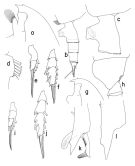 issued from : T. Park in Bull. Scripps Inst. Oceanogr. Univ. California, San Diego, 1995, 29. [p.147, Fig.37]. Female (from northern Atlantic): a, forehead (left side); b, urosome (left); c, genital somite (left); d,outer lobe of Mx1; e, exopod of P1 (anterior); f, exopod of P2 (anterior). Nota: Rostrum highly variable in size from a small spiniform process (inversely related to body size) to a large, elongate one in the small individuals. Urosome robust in large individuals (from higher latitudes) but becomes more slender with decrease in body size toward lower latitudes. Laterally, dorsal wall of genital somite nearly straight or with an inconspicuous hump just posterior to middle. Genital prominence in lateral view high and directed downward; its is narrower in small individualks. Ventral margin of genital flange emarginate; posterior lobe of the flange is well defined. Posterior edge of genital field only slightly produced to form a low and wide ridge. Posterior margin of genital prpminence sloping onto posterior ventral wall of somite. Cephalosomal appendages similar to those of P. malayensis except that outer lobe of Mx1 with 5 long setae in addition to 1 small and 2 or 3 minute setae proximally. Male (from southeastern Pacific): g, forehead (left); h, last pedigerous and genital somites (left); i, exopod of P1 (anterior); j, exopod of P2 (anterior); k, distal exopodal segments of left 5th leg (lateral, tilted clockwise); l, serrated lamella of left 5th leg exopodal (lateral).
|
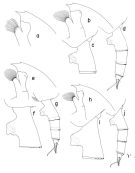 issued from : T. Park in Bull. Scripps Inst. Oceanogr. Univ. California, San Diego, 1995, 29. [p.148, Fig.38]. Females: From Gulf of Mexico: a, forehead (left side). From southeastern Pacific: b, forehead (left); c, genital somite (left); d, urosome (left). From East China Sea: e, forehead (left); f, genital somite (left); g, urosome (left). From eastern Indian Ocean: h, forehead (left); i, genital somite (left); j, urosome (left).
|
 issued from : T. Park in Antarctic Res. Ser. Washington, 1978, 27. [p.251, Fig.97]. As Euchaeta sarsi. Female: A, forehead (lateral); B, C, posterior part of metasome and urosome (left side and dorsal, respectively); D, E, distal end of metasome and genital segment (ventral and left side, respectively); F, outer lobe of Mx1; G, P1; H, P2. P1-2: legs (anterior).
|
 issued from : T. Park in Antarctic Res. Ser. Washington, 1978, 27. [p.252, Fig.98]. As Euchaeta sarsi. Male: A, forehead (lateral); B, C, last metasomal and genital segments (left side and right side, respectively); D, P1; E, P2; F, P5; G, distal part of exopod of left P5 (anterior); H, serrated lamella of left P5 (lateral). P1-5: legs (anterior).
|
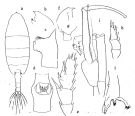 issued from : O. Tanaka in Publs Seto Mar. Biol. Lab., 1958, VI (3). [p., Fig.]. As Pareuchaeta sarsi. Female: a, habitus (dorsal); b, forehead (lateral); c, last thoracic segment and genital somite; (lateral left side); d, genital somite (ventral); e, exopod of P2. Nota: The first three urosome segments have the proportional lengths 19:10:10. A1 extends about the end of the cephalothorax. Male: f, forehead (lateral); g, last thoracic segment and genital segment (lateral right side); h, exopod of P1; i, P5; j, terminal segments of left P5. Nota: The urosome segments and furca are in the proportional lengths as 22:27:25:17:2:7 = 100.
|
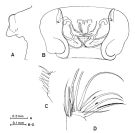 issued from : O. Tanaka & M. Omori in Publs Seto Mar. Biol. Lab., 1968, XVI (4). [p.251, Fig.18]. As Pareuchaeta sarsi. Female: A, genital somite (part.) (lateral left side); B, genital complex (ventral); C, outer lobe of Mx1; D, endopod and 2nd basal segment of Mx1. Nota: The urosome segments and furca are in the proportional lengths as 44:22:20:2:12 = 100. Prosome and urosome are in the proportional lengths as 74 to 26.
|
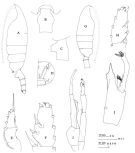 issued from : J.M. Bradford, L. Haakonssen & J.B. Jillett in Mem. N.Z. Oceanogr. Inst., 1983, 90. [p.55, Fig.29]. Female: A, habitus (lateral left side); B, genital segment (dorsal); C, idem (lateral left side); D, genital field (ventral, half); E, exopod of P1; F, exopod segment 3 of P2. Nota: - P1 exopod female: Aa minute; Bb = 4/5 BC; Cc >BC. - P2 exopod famale: Aa = AB + 1/2 Bb; Bb = 1/2 BC; Cc = 2/3 CD; Dd = 1/4 CD. . (see code of lengths outer spines in the Genus' figure, or in Paraeuchaeta sp. A). This female is very similar to P. californica, P. regalis, P. polita and P. simulantis, but can be distinguished by the number of setae on Mx1 and details of the genital segment. Male: G, Prosome and 1st and 2nd urosomal segments (lateral right side); H, exopod segment 3 of P2; I, P5; J, medial view of terminal part of left P5 exopod (digitiform process missing on this specimen). Nota: - P1 exopod male: Aa minute; Bb = 2/5 BC; Cc = 2/3 CD. P2 exopod male: Aa = 1/2 AB; Bb = 1/2 Cc; Cc < 1/2 CD; Dd = 1/3 CD. (see code of lengths outer spines in the Genus' figure, or in Paraeuchaeta sp. A). The relative lengths of the serrated lamella and exopod segment 3 are more like that figured by A. Scott (1909) than those of Tanaka (1958) and Park (1978).
|
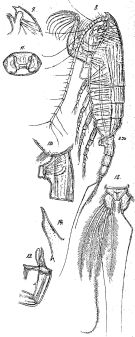 Issued from : G.O. Sars in Résult. Camp. Scient. Prince Albert I, 69, pls.1-127 (1924). [Pl.XXXI, figs.8-14]. As Pareuchaeta sarsi. Female: habitus (lateral left side); 9, forehead (lateral); 10, posterior part cephalothorax and genital segment (lateral left side); 11, genital complex (ventral); 12, anal segment and caudal rami (dorsal). Male: 13, distal segments of left P5; 14, denticulate lamella (enlarged).
|
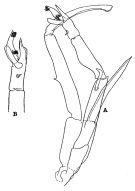 issued from : R.B.S. Sewell in The John Murray Expedition, 1933-34, Scientific Reports, VIII (1), 1947. [p.128, Fig.429, A-B]. Male (from Arabian Sea): A, P5; B, clasping organ of left P5. Nota: The spinous process of the terminal segment of the left P5 is sharply constricted at about 2/3 of its length and then tapers to a sharp point.; the middle smooth, blunty rounded process is distintly, though slightly, shorter than the spinous process Remarks female: The proportional lengths of the cephalothorax and abdomen as 66 to 40. The proportional lengths of the various segments of the body (cephalon to caudal rami) as 415:84:84:78:133:76:71:12:47 = 1000. Genital segment witout trace of any lateral tubercle.
|
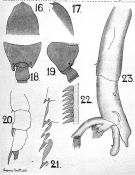 issued from : A. Scott in Siboga-Expedition, 1909, XIX a. [Plate XXI, Figs.16-23]. As Paraeuchaeta dentata. Male (from Banda Sea): 16, forehead (dorsal); 17, idem (lateral); 18, last thoracic and genital segments (dorsal); 19, idem (left side); 20, P1 (rxopodite only); 21, P2 (outer margin of exopodite); 22, part of terminal spine (exopodite of P3); 23, P5 (part of left leg).
|
 issued from : G.P. Farran in Fish. Ire. Sci. Invest., 1906, II [1908]. [Pl. III, Figs.15-16]. As Euchaeta Sarsi. Female (from W Ireland): 15, genital segment (lateral); 16, exopod of P2.
|
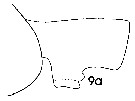 issued from : J. Mauchline in ICES Ident. Leafl. Plankton, 1999, N°182. [p.3, Fig.2: 9a]. As Euchaeta sarsi. Female (Northeast Atlantic): 9a, genital double-somite (left side).
|
 issued from : J. Mauchline in ICES Ident. Leafl. Plankton, 1999, N°182. [p.4, Fig.3: 9b]. Male (Northeast Atlantic): 9b, terminal two segments, exopodal segments of left P5.
|
 issued from : C. With in The Danish Ingolf-Expedition, 1915, III (4). [p.178, Text-Fig.50]. As Euchaete sarsi. Female (from 61°30'N, 17°08'W): a-d, genital segment (lateral, left side); e, same (dorsal); f, genital area (ventral); a-e from different specimens.
|
 issued from : C. With in The Danish Ingolf-Expedition, Copepoda I, 1915, III, 4. [Pl. VI, Fig.7, a]. As Euchaete sarsi. Female: a, labrum (anterior surface).
|
 Issued from : T. Park in Smithsonian Contr. Zool., 1975, 196. [p.20, Fig.17]. As Euchaeta sarsi. Female (from G. of Mexico): a, forehead (lateral); b, genital segment (ventral); c, same (lateral). fL = length of genital flange; sl = length of genital segment posterior to genital flange. Male: d, forehead (lateral); e, P1 (anterior); f, exopod of P2 (anterior); g, exopod of left P5 (anterior); h, same (lateral); i, same (medial). Nota: This species is found in tows down to depths exceeding 1000 m.
|
 Paraeuchaeta sarsi Paraeuchaeta sarsi Female: 1 - See key to species Groups and independent species of Paraeuchaeta (p.30): malayensis species Group. 2 - Outer spine of 2nd exopodal segment (or the 2nd of the first 2 exopodal segments forming a proximal, compound segment) of P1 normally developed (Fig.37-e). 3 - Outer lobe of Mx1 with 5 long setae in addition to some very small setae proximally (Fig.37-d). 4 - Laterally, genital prominence high with emarginate genital flanges (Fig.37-c). Laterally, genital somite with relatively short posterior ventral wall; genital flange slightly emarginate (Fig.37-c).
| | | | | Compl. Ref.: | | | De Decker & Mombeck, 1964 (p.13); Morris R.J., 1971 (p.275, Table 1, 2, lipids composition); Roe, 1972 (p.277, tabl.1, tabl.2); Suarez-Morales & Gasca, 1998 a (p.109); Lapernat, 2000 (tabl. 3, 4); Razouls & al., 2000 (p.343, Appendix); Berasategui & al., 2005 (p.313, fig.2); Neumann-Leitao & al., 2008 (p.799: Tab.II, fig.6); Park & Ferrari, 2009 (p.143, Table 5, Appendix 1, biogeography); Mazzocchi & Di Capua, 2010 (p.425); Bonecker & a., 2014 (p.445, Table II: frequency, horizontal & vertical distributions);El Arraj & al., 2017 (p.272, table 2); Belmonte, 2018 (p.273, Table I: Italian zones) | | | | NZ: | 20 | | |
|
Distribution map of Paraeuchaeta sarsi by geographical zones
|
| | | | | | | | | | | | | | |  Chart of 1996 Chart of 1996 | |
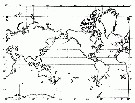 issued from : T. Park in Hydrobiologia 292/293, 1994. [Fig. 2, p.326].
Geographical distribution of Paraeuchaeta sarsi (lozange). issued from : T. Park in Hydrobiologia 292/293, 1994. [Fig. 2, p.326].
Geographical distribution of Paraeuchaeta sarsi (lozange). |
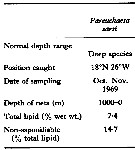 Issued from : R. J. Morris in Comp. Biochem. Physiol., 1971, 40B. [p.277, Table 1]. Issued from : R. J. Morris in Comp. Biochem. Physiol., 1971, 40B. [p.277, Table 1].
Total lipid and saponification for Paraeuchaeta sarsi from the Northeastern Atlantic. |
| | | | Loc: | | | Antarct. (South Georgia, SW Atlant., Indian, SE Pacif., Drake Passage), sub-Antarct. (SW Atlant., Indian, SW & SE Pacif.), Sourh Africa (E), off Gabon, Argentina, Cabo Frio, off Mauritania, off Morocco-Mauritania, Canary Is., G. of Mexico, Caribbean Sea, Brazil, off Rio de Janeiro, N Atlant., S Davis Strait, S Iceland, off Rockall Is., Faroe Is., off W Ireland, Bay of Biscay, W Medit. (Ligurian Sea, Tyrrhenian Sea), Arabian Sea, Indian, Indonesia-Malaysia, Philippines, China Seas (East China Sea), Japan, off Kuril Is., British Columbia , Tasman Sea, New Zealand, SW Galapagos, off Juan Fernandez Is., off Peru | | | | N: | 40 | | | | Lg.: | | | (1) F: 8,7; (3) F: 11,3-7,8; M: 9,4-6,8; (5) M: 8; (7) F: 10; (9) F: 10-8,2; M: ± 7,7,2; (11) F: 8,47; (14) F: 8,97-7,8; M: 8,15; (19) F: 9,41-8,5; M: 7,41-7; (20) F: 10,66-9,83; M: 8,33; (24) F: 10,2-9,8; (63) F: 9,68-8,45; M: 7,93-7,31; (70) F: 9,4; (99) F: 9,7-8,3; M: 7,71-6,94; (199) F: 8,8-7,84; M: 8,6-6,72; (244) F: 8,5; (806) F: 8,5-6,9; {F: 6,90-11,30; M: 6,72-9,40}
The mean female size is 9.028 mm (n = 25; SD = 1.0268), and the mean male size is 7.679 mm (n = 14; SD = 0.7726). The size ratio (male : female) is 0.851 (n = 8; SD = 0.0655), or ± 85 %. | | | | Rem.: | bathypelagic.
Sampling depth (Antarct., sub-Antarct.) : 0-600-4000 m.
For Farran (1908b, p.42) this species is undoubtedly the E. barbata of Wolfenden and possibly also that of Sars (1903), although the size given by the latter (12 mm) is rather larger, and the proportionate lengths of the caudal setae not quite the same; the figure of the genital segment is also slightly different.
For Vervoort (1957, p.84) the male recorded by A. Scott from the Malay Archipelago as P. dentata, very probably represents the male of P. sarsi.
Park (1995, p.49) found this species widely in the Atlantic between 65°N and 36°S, in the South Pacific between 35°S and 49°S, the Malay Archipelago, the East China Sea, off southern Japan, and the tropical eastern Indian Ocean. | | | Last update : 24/10/2022 | |
|
|
 Any use of this site for a publication will be mentioned with the following reference : Any use of this site for a publication will be mentioned with the following reference :
Razouls C., Desreumaux N., Kouwenberg J. and de Bovée F., 2005-2026. - Biodiversity of Marine Planktonic Copepods (morphology, geographical distribution and biological data). Sorbonne University, CNRS. Available at http://copepodes.obs-banyuls.fr/en [Accessed January 07, 2026] © copyright 2005-2026 Sorbonne University, CNRS
|
|
 |
 |



















